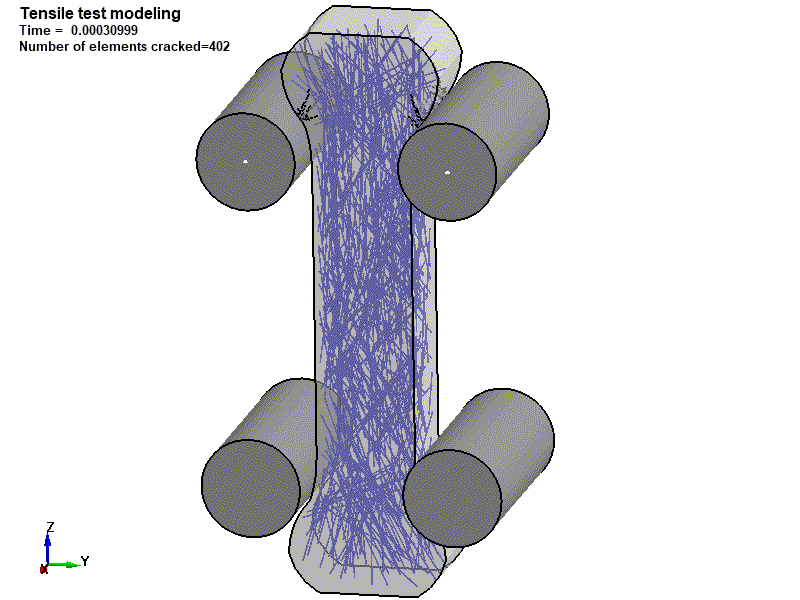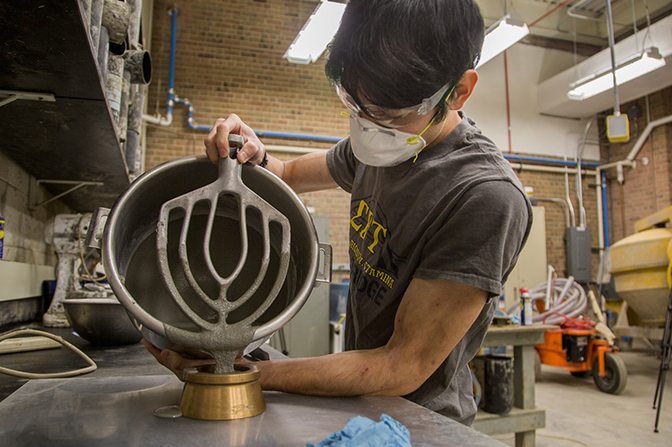Roads and bridges would last longer, save money with new concrete formula
U-M researchers to offer non-proprietary concrete formula free of charge.
U-M researchers to offer non-proprietary concrete formula free of charge.
Passing beneath a crumbling overpass or rumbling over a pothole-riddled street in almost any U.S. city, it’s hard not to wonder: why don’t they make these things out of something that lasts longer?
Stronger and more durable concrete – known as ultra high-performance concrete (UHPC) – has been on the market for a while under a small handful of brand names. But high prices have kept it out of widespread use by local, state and federal governments.
As a result, governments are forced to repeatedly fix and replace aging infrastructure, leading to a backlog of roughly $500 billion in critically needed road and bridge repairs.
At the request of Michigan’s Department of Transportation (MDOT), University of Michigan engineers have concocted a non-proprietary blend of UHPC that comes with a drastically-reduced cost. That concrete is currently in use on a bridge in St. Clair County, and the formula is being made available for free.
“Regular concrete will have a strength of about 4,000 pounds per square inch (psi)… that’s maybe the weight of an SUV on every square inch,” said Sherif El-Tawil, a U-M professor of civil and environmental engineering. “However, UHPC can support at least 22,000 psi or six times as much.”
Our UHPC brings down the cost of long-term maintenance. It’s still more expensive than regular concrete, but if you consider the effect over the lifetime of a bridge, then the cost becomes very competitive.
In addition to strength, El-Tawil’s research team is boosting concrete durability – a property measured in freeze-thaw cycles. Ordinary concrete tested in the lab showed deterioration at 28 freeze-thaw cycles. The team’s UHPC blend showed virtually no deterioration after 90 cycles.
A municipality looking to replace a bridge or rebuild a crumbling road, might spend $100 to $120 per cubic yard of regular concrete. To upgrade to a brand-name UHPC, that same local government would be looking at paying $3,000 – $4,000 per cubic yard.
In 2016, Michigan’s Department of Transportation outlined the problem with commercially-available brands of UHPC in a research publication.
“While the durability properties of UHPC are very attractive… mixes are currently prohibitively expensive for widespread use and require specialized equipment and curing practices…,” MDOT’s research report stated. “But if costs were reduced…(it) could have potential…including thin overlays for decks that now need to be replaced every few decades.”

Reaching that extreme level of strength and durability requires modification to the traditional concrete recipe. The formula for regular concrete contains some fairly simple ingredients – cement, gravel, sand and water. To get UHPC, El-Tawil removed the gravel in favor of different types of sand. Using ideas from the pharmaceutical industry, the particle sizes of the sands are carefully selected so that the resulting UHPC mixture has a structure that is densely packed.
Higher density leads to fewer voids inside, reducing the opportunities for water to penetrate and cause problems during the freeze-thaw process. The dense packing is also the reason why UHPC is so strong.
To reduce the carbon footprint of the material, a byproduct of the steelmaking industry (ground slag) is used to replace a significant portion of the cement and, at the same time, help increase the packing density.
A key ingredient in UHPC that is not in regular concrete is steel fibers. Isaya Miyata, a senior studying civil engineering, is among those who make sample batches of UHPC in a mixing lab on U-M’s North Campus.
“Steel fibers add strain-hardening properties to the concrete,” he said. “So basically, once it yields the concrete will take a lot more load before it ultimately fails…”
While the fibers themselves are small, roughly a half-inch in length, they have an outsize impact on the final price of UHPC. They come from chopped up thin wires such as those used in steel-belted tires. There aren’t many other uses for them, therefore they are quite expensive.

Because of the fibers, the UHPC created at U-M is still more expensive than regular concrete. But it represents a 70 percent price drop from the UHPC brands currently on the market. And as the cost of steel fibers drops with increasing demand, the cost of the U-M concrete would also fall.
“Our UHPC brings down the cost of long-term maintenance,” El-Tawil said. “It’s still more expensive than regular concrete, but if you consider the effect over the lifetime of a bridge, then the cost becomes very competitive.
“If you have a concrete deck on a bridge that lives for 200 years with little to no maintenance … imagine the cost savings.”